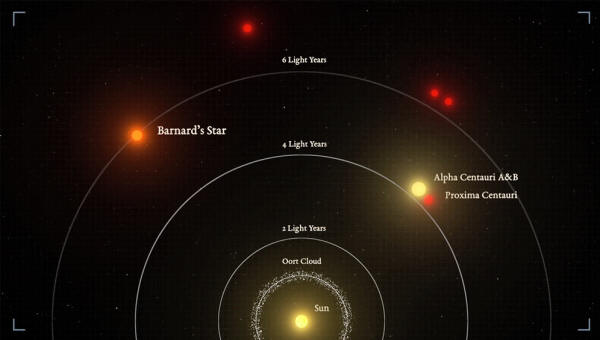|

by Ben Lewis
November 15,
2018
from
CosmosMagazine Website

An unusually heliocentric illustration
showing
the proximity of Barnard's Star to the sun.
IEEC/Science-Wave - Guillem Ramisa
A planet
three times
bigger than Earth
orbits a star
just six light-years away...
Astronomers have announced the discovery of a super-Earth in our
relative neighborhood.
The planet measures around 3.2 times the mass of Earth, and was
discovered orbiting Barnard's Star, fewer than six light-years from
the sun.
That makes it the second
closest
exoplanet to Earth, according to
Ignasi Ribas from the Institute of Space Studies of Catalonia in
Spain.
The planet, the description of which is published (A
candidate Super-Earth Planet orbiting near the Snow Line of
Barnard's Star) in the journal Nature, was
discovered by same projects which have previously discovered the
exoplanet Proxima b, orbiting our closest star
Proxima Centauri.

A planet orbiting the closest star to Earth,
Proxima Centauri
Source
A red dwarf that predates the solar system,
Barnard's Star is the closest
solitary star to the sun.
Its proximity to the
solar system has made it a long-running candidate in the hunt for
exoplanets, but previous searches have found none.
Analyzing more than 20 years of data, Ribas found the planet
orbiting its host at just 40% of the equivalent distance that the
Earth orbits the sun - roughly the same distance out as Mercury.
That means it has a "year" of about 233 days. Even at such a close
distance the planet would still have a dim existence, because
Barnard's Star emits far less energy than the sun.
This places the exoplanet close to the "snow line", the region where
volatile compounds such as water can condense into solid ice.
The researchers write
that this freezing, shadowy world could have a temperature of minus
-170º Celsius, probably making it inhospitable for 'life as we
know it'...
"After a very careful
analysis, we are 99% confident that the planet is there," says
Ribas.
They haven't, however,
ruled out the possibility of at least one other planet further out
from the star.
|



